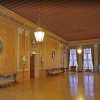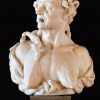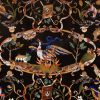In the traditional structure of the Venetian palace the portego, or connecting hall, was the largest area in the building, and it played the role of reception room. In Longhena’s project which was then revised by Massari, this role has been taken over by the main central room, a type of room imported to Venice from the architecture of the Roman palaces. Thus the portego became simply a connecting element between the rooms and the staircase leading to the other floors.
This area was once decorated by four canvases with religious subjects by Luca Giordano, which were then sold during the 19th century. Now it contains 18th-century marble busts inside niches or on brackets showing portraits and allegorical figures, while the walls are lined in pink marmorino polished plaster. Sofas of refined rocaille taste, carved walnut trestle tables and an elegant gilded sedan chair upholstered in red silk complete the furnishings.
Among the ornamental sculptures to the right of the sedan chair, is a remarkable bust of Envy, the work of Giusto Le Cour. The author shows with highly convincing naturalism the allegory described by Cesare Ripa in his Iconologia as an “old, ugly, and pale woman, her body is lean and wasted, with malevolent eyes and dishevelled hair, and snakes swarm from her head”. Quite different is instead the carnal and languid Lucretia visible against the same wall on the left, by Filippo Parodi, a Genoese sculptor also active in Venice.
On either side of the doorway, which is almost a triumphal arch dominated by the Rezzonico coat-of-arms, are two sculptures by Alessandro Vittoria, originally two telamons holding up the hood of the imposing late 16th-century fireplace.
The two large console tables against the wall feature two superb hard stone inlaid tops by Benedetto Corberelli, a member of a Florentine family active in northern Italy during the seventeenth and eighteenth centuries, specialized in the production of this kind of artefacts. Created for Bishop Francesco Pisani, the two table tops show a rich decoration with floral spirals and interlaced branches that surround a central medallion depicting Orpheus and the Phoenix respectively. Animals and colourful birds peep out from among the branches, while episodes from Aesop’s fables can be recognized in the corners.


